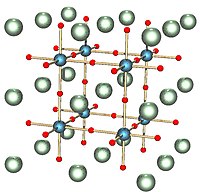
Photo from wikipedia
Abstract This study examines the oxidation and coordination of lead (Pb) in the uranium (U) minerals uraninite (UO2), coffinite (USiO4), and brannerite (UTi2O6), and minerals that have U as a… Click to show full abstract
Abstract This study examines the oxidation and coordination of lead (Pb) in the uranium (U) minerals uraninite (UO2), coffinite (USiO4), and brannerite (UTi2O6), and minerals that have U as a minor constituent, zircon (ZrSiO4) and titanite (CaTiSiO5). The characterization of Pb was conducted through a combination of micro-synchrotron X-ray fluorescence mapping (µSXRF) and micro-X-ray absorption spectroscopy (µXAS), collected at the Pb LII and LIII edge on characterized grains (electron microscopy and X-ray diffraction) from a range of geological settings and ages. For all minerals considered in this study, Pb LII and LIII X-ray absorption near-edge structure (XANES) and extended X-ray absorption fine structure (EXAFS) data indicate that Pb exists as Pb2+. In the case of uraninite, DFT structure optimization calculations suggest that the substitution of Pb2+ for U4+ is facilitated by the stereochemically active electron lone pair indicative of Pb2+, which effectively takes the place of an oxygen vacancy (coupled substitution Pb2+ + □ = U4+ + O2−). In detail, however, the EXAFS and XANES data, supported by first principle calculations of the XANES associated with Pb2+ replacing U4+ in the crystal lattice of uraninite, indicate that Pb2+ is present in a less distorted coordination than suggested by DFT, which may reflect a yet to be characterized link between interstitial oxygen defects and Pb2+ incorporation, rather than a simple oxygen vacancy. For coffinite, the XANES data demonstrate that Pb exists mainly as Pb2+ in the form of galena, indicating limited stability of the isomorphous substitution in coffinite. In contrast, Pb is homogeneously distributed in the metamict mineral brannerite, which displays a distinct XANES spectrum suggestive of Pb2+ bonded to oxygens in a highly distorted coordination environment. Pb LII XANES indicate that radiogenic Pb exists predominantly as Pb2+ within the crystal lattice of zircon and as distinct mineral PbO nano-scale inclusions or domains. Additionally, Pb LII XANES measurements also indicate that Pb2+ exists within titanite although the coordination environment is unclear. Overall, these data suggest that the previous indications of the presence of Pb4+ in radioactive minerals need to be reconsidered. The nature of radiogenic Pb2+ incorporation in U-bearing minerals controls the mobilization of Pb in hydrothermal fluids and the utility of a mineral as a geochronometer. The Pb valence and coordination data presented in this study provide fundamental constraints imperative for our understanding of the controls governing the mobilization of radiogenic Pb during water-rock interaction and metamorphism.
Journal Title: Geochimica et Cosmochimica Acta
Year Published: 2019
Link to full text (if available)
Share on Social Media: Sign Up to like & get
recommendations!